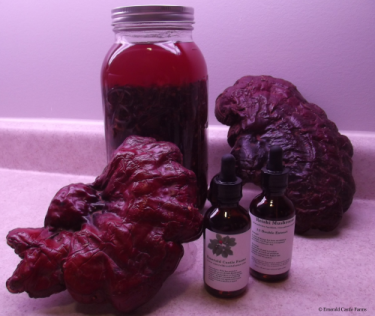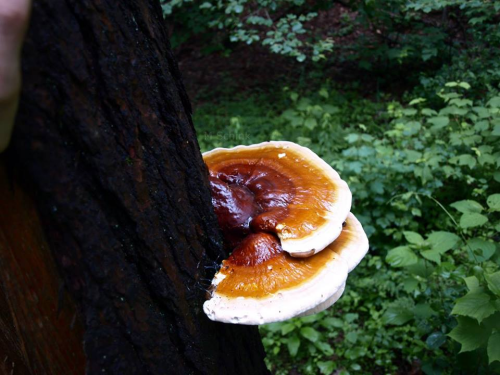
Photo Courtesy Matt Schink
Reishi Mushroom Products
(Ganoderma lucidum)
(Ganoderma tsugae)
Reishi (or Ling zhi) can manifest in various colors and forms, but the most common are only stems (called antlered) or stems with a kidney shaped conk on top. The common coloration is dark red to brown and characteristically a white or yellow new growth zone at the edge. G. lucidum typically grows on hardwoods whereas G. tsugae likes hemlocks. However, Stamets (1993) noted that G. lucidum will readily grow on evergreen medium in cultivation. Ganoderma species are white rot polypore fungi which invades dead and dying trees. Both species of Ganoderma are found growing wild in the northeastern United States and are very difficult (if not impossible) to tell apart visually.
Reishi is called Ling Zhi in China where it has been used for thousands of years as a powerful medicinal mushroom. Studies have shown reishi to enhance the immune system, to combat tumors and have protective action. Rogers (2011) notes the wide range of medicinal benefits and reishi’s similarity to ginseng as an adaptogen.
What’s in a name?
G. lucidum vs G. tsugae
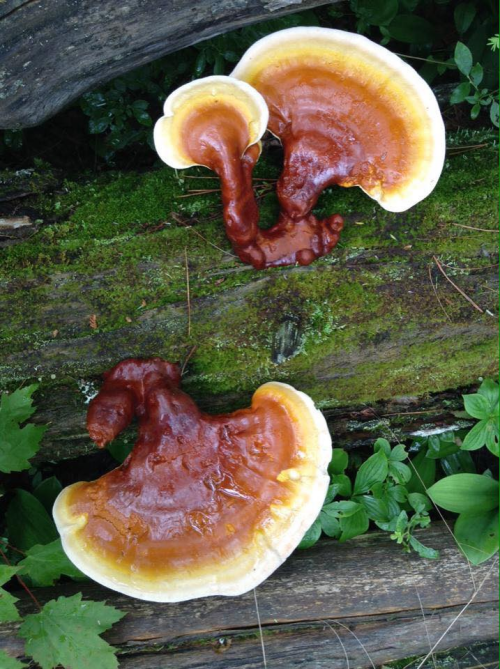
Photo of Ganoderma lucidum Courtesy Rita Murphy
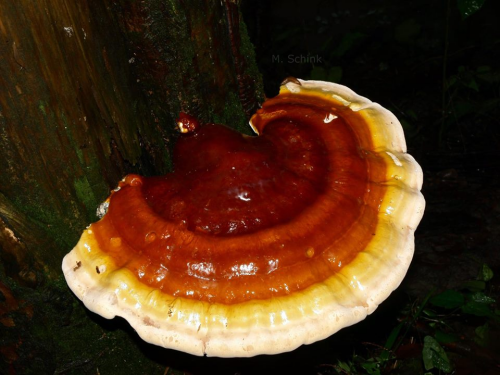
Photo of Ganoderma tsugae Courtesy Matt Schink
Because of the visual similarities and geographic overlap of G. lucidum and G. tsugae in the United States, the question becomes whether or not it matters which species one uses in preparations used medicinally. Based on my own research (some of which is outlined below), I would be very comfortable completely dismissing the question entirely.
There are a host of Ganoderma species of mushrooms which are often referred to as “reishi.” The standard bearer is Ganoderma lucidum and most medical studies have identified this species as the one they have used. However, there are some studies being done with G. tsugae also and the results are just as promising as those of its very close relative G. lucidum. In fact, there are questions as to whether the two types of Ganoderma are actually separate species.
Paul Stamets –a well known and respected mycologist- suggested G. lucidum, G. curtisii, G. oregonense and G. tsugae are so closely related and similar that maintaining they are separate species is “primarily ecological and host specific and not biological” (1993, p. 357). Hobbs (1995) noted that G. tsugae was one of the major species of Ganoderma being cultivated in Taiwan and that it had similar constituents as G. lucidum which were connected to successful animal studies. Moncalvo (2005) referred to the complexity and lack of micromorphological distinctiveness in the Ganoderma mushrooms. He went on to point out that the reishi mushrooms “reported as G. lucidum in most of the pharmacological and phytopathological studies were wrongly identified” (p. 353). In fact, many of the strains grown in Asia for health and medical related use are not G. lucidum and actually include many distinct Ganoderma species (Moncalvo, 2005). Confusion in identification and labeling of the Ganoderma mushrooms was also shown by Hong and Jung (2004). In their study, they used rDNA to group similar strains of Ganoderma. The Asian G. lucidum group included six species from Japan and Korea, and one identified as G. oerstedil from Argentina. The G. tsugae group included three species identified as G. lucidum, four as G. tsugae, two G. oregonense, two G. valesiacum and one G. oerstedil. The origins of the G. tsugae group in Hong and Jung’s study were primarily the United States and Canada, but included species from the UK, France and Argentina. Moncalvo noted that most reishi labeled as G. lucidum from North America are very similar to G. resinaceum from Europe. Further that “G. tsugae in North America is genetically very close to the ‘true’ G. lucidum from Europe” (p. 353).
What all that means is whether the reishi used in an extract is Ganoderma lucidum or Ganoderma tsugae, there is no reason to believe generally that it would work any differently. With scientific evidence suggesting that reishi strains used in clinical trials labeled as G. lucidum potentially being misidentified, and the closeness of G. lucidum and G. tsugae evidenced in the literature, it would seem that one could arguably interchange the two species with no negative effects.
Hobbs, C. (1995). Medicinal mushrooms: an exploration of tradition, healing and culture.
Hong, S. G., & Jung, H. S. (2004). Phylogenetic analysis of Ganoderma based on nearly completemitochondrial small-subunit ribosomal DNA sequences. Mycologia, 96(4), 742-755.
Moncalvo, J. M. (2005). Molecular Systematics of Ganoderma: What Is Reishi?. International Journalof Medicinal Mushrooms, 7(3).
Rogers, R. (2011). The fungal pharmacy: the complete guide to medicinal mushrooms and lichens ofNorth America. North Atlantic Books.
Stamets, P. (1993). Growing gourmet and medicinal mushrooms: A companion guide tothe mushroom cultivator. Ten Speed Press.
Reishi from Emerald Castle Farms
We use both alcohol and water to extract the most beneficial substances from the raw material. Hence, a double extract. We first extract over time (at least a month) in alcohol. We then normally do three water extractions on the material after we remove the alcohol extract. The water extracts are then reduced to a similar volume as the alcohol extract. The alcohol and water extracts are then combined to provide a robust extract product that consists of approximately 25% alcohol by volume. After combining, the raw extract is then allowed to rest to remove unwanted sediments. The finished extract is then packaged in new bottles, labeled, and sealed to be tamper proof.
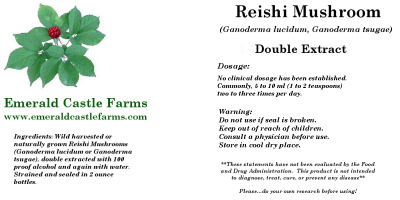
Reishi Extract
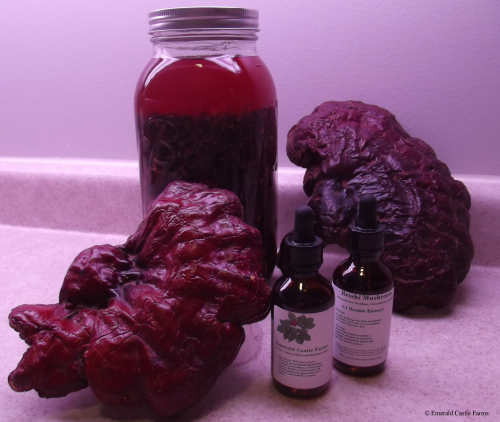
| Reishi Double Extract -call to inquire |
|---|
About Reishi and its Benefits
When I started working on the reishi research to create this page, I was once again stunned by the fact that more people are not aware of the documented healing properties of this medicinal mushroom. I felt the same way when I put the chaga page together. In the research listed below, I found that not only has reishi been used for thousands of years as a medicine for nearly everything, but the scientific studies are proving the folk lore surrounding this highly useful medicinal mushroom. From promoting health and longevity in China to fighting HIV and cancer to protecting liver and kidney tissue from exposure to heavy metals, reishi is proven to be an effective weapon for improved health. Numerous studies have found anti-cancer and anti-tumor effects using reishi. For example, Liu, Yuan, Chung and Chen (2002) found that a preparation from reishi inhibited three types of tumors from 80-90%. Please keep in mind that I am not making any claims of any kind. These statements have not been evaluated by the Food & Drug Administration. These products are not intended to diagnose, treat, cure, or prevent any disease. I am only sharing my research with you -which is referenced here on the page.
While I could go on and on page after page citing scientific studies which show the health benefits of reishi, I don't have that kind of time. Additionally, I think it is important for you to do your own research before adding any dietary supplement or medicinal agent to your routine. However, I've done some basic research and listed it below to get you going.
Within your research you should find a few precautions for the use of reishi. Reishi has an antiplatelet effect, so don’t take reishi if you are on anticoagulants or antiplatelet drugs without consulting your doctor. Likewise, reishi tends to reduce blood pressure and may interact with blood pressure medications. Consult your doctor if you are taking blood pressure medications before taking reishi. Reishi enhances the immune system response, so don’t take reishi if you are taking immunosuppressant medications. Since reishi can increase antioxidant capacity in plasma, it might interact with some chemotherapeutic agents. If you are being treated with chemotherapy, consult your doctor before using. And specifically reishi constituents may have inhibitory action with Cytochrome P450 substrates which may affect the concentration of these drugs. Don’t take reishi if you are taking Cytochrome P450 drugs without approval of your doctor.
As with any natural substance, these products cannot be patented. As a result, the big pharmacuiticle companies have nothing to gain in sponsoring human clinical trials to prove these natural substances work. The United States Food and Drug Administration requires specific compounds with proven specific modes of action before they will approve any medicinal substance. In the case of plants and fungi, this is difficult because they are made up of sometimes thousands of different constituents. Sliva et al. (2002) wrote in part "spores and unpurified fruiting body of G. lucidum inhibit invasion of breast and prostate cancer cells." Some studies -such as Weng and Yen (2010)- tend to give the impression that trying to pick apart the constituents of these natural compounds reduce their effectiveness.
Scientific studies have shown positive results in vitro and in animal studies. In a few cases, reishi has even been tested in human clinical studies. Below are a few specific areas noted in the studies where reishi shows positive effects. Keep in mind, this list is based only on the studies mentioned on this page and are listed in alphabetical order: By no means is this an exhaustive list of the studies done with reishi which suggest positive benefits.
Anti-cancer 1, 4, 6.7, 18, 24, 25, 27, 29
Anti-coagulatory effects 11
Antidiabetic effects 3
Anti-inflammatory 5, 9, 10
Anti-leukemic activity 18, 24
Antioxidant action 9, 17, 20, 21
Anti-tumor 2, 8, 10, 13, 18, 24, 25, 27
Human breast cancer 18
Human lung cancer 19
Human ovarian cancer 29
Human prostate cancer 18
Immunomodulatory activity 1, 2, 4, 5, 8, 11, 24, 25, 27
Kidney protective activity 16, 17
Liver protective activity 9, 17
Prostate / urinary tract health 14, 15
Supportive of common cancer treatments 12, 13, 16, 23, 27, 29
Ulcer healing effects 5
White blood cell protective activity 8
Here are a few helpful links to get you started:
Guide to Reishi Mushrooms Research PageWebMD on Reishi
Health Benefits Of Reishi Mushrooms
Natural News Article from 2007
Memorial Sloan Kettering Cancer Center Reishi page
Some scientific studies with reishi
- Chang, C. J., Chen, Y. Y. M., Lu, C. C., Lin, C. S., Martel, J., Tsai, S. H., ... & Lai, H. C. (2013). Ganoderma lucidum stimulates NK cell cytotoxicity by inducing NKG2D/NCR activation and secretion of perforin and granulysin. Innate immunity, 1753425913491789.
- “G. lucidum induces NK cell cytotoxicity against various cancer cell lines” In other words, reshi extracts enhance the ability of natural killer cells to kill cancer cells of various types.
- Chen, H. S., Tsai, Y. F., Lin, S., Lin, C. C., Khoo, K. H., Lin, C. H., & Wong, C. H. (2004). Studies on the immuno-modulating and anti-tumor activities of Ganoderma lucidum (Reishi) polysaccharides. Bioorganic & Medicinal Chemistry, 12(21), 5595-5601.
- In this study, reishi constituents were found to stimulate the immune system and have anti tumor effects.
- Chu, T. T., Benzie, I. F., Lam, C. W., Fok, B. S., Lee, K. K., & Tomlinson, B. (2012). Study of potential cardioprotective effects of Ganoderma lucidum (Lingzhi): results of a controlled human intervention trial. British journal of nutrition, 107(07), 1017-1027.
- HUMAN CLINICAL TRIAL This was a double-blind cross-over study in which: “Results indicate that Lingzhi might have mild antidiabetic effects and potentially improve the dyslipidemia of diabetes”
- Gao, Y., Zhou, S., Jiang, W., Huang, M., & Dai, X. (2003). Effects of Ganopoly®(A ganoderma lucidum polysaccharide extract) on the immune functions in Advanced-Stage cancer patients. Immunological investigations, 32(3), 201-215.
- HUMAN CLINICAL TRAIL constituents of reshi mushrooms given to advanced stage cancer patients. It was found that the treatment enhanced immune responses in the patients. Also, it was found that a significant increase in natural killer cells occurred.
- Gao, Y., Zhou, S., Wen, J., Huang, M., & Xu, A. (2002). Mechanism of the antiulcerogenic effect of Ganoderma lucidum polysaccharides on indomethacin-induced lesions in the rat. Life sciences, 72(6), 731-745.
- This study was consistent with a prior study that reishi constituents produced a healing effect in rats with gastric mucosal lesions (ulcers). Additional anti-inflammatory actions were observed.
- Gordan, J. D., Chay, W. Y., Kelley, R. K., Ko, A. H., Choo, S. P., & Venook, A. P. (2011). And what other medications are you taking?. Journal of Clinical Oncology, 29(11), e288-e291.
- HUMAN CASE STUDY "Spontaneous remission” were often documented where no conventional cancer treatments were had, but patients had been taking “hebal preparations, particularly Traditions Chinese Medicine”
- Remission of liver cancer reported in several specific cases
- Hiyamaqj, T., Yoshitaka, U. E. N. O., Masanori, I. T. O., Kitadain, Y., Yoshihara, M., & Chayanlaflj, K. (2010). A Water—soluble Extract from Culture Medium of Ganoderma lucidum Mycelia Suppresses the Development of Colorectal Adenomas. Hiroshima J. Med. Sci, 59(1), 1-6.
- HUMAN CLINICAL TRIAL Patients who had colorectal adenomas (precancerous lesions of the large bowel) were given reshi mycelia for twelve months. The results showed that the control group which did not receive reshi developed more adenomas and those they had increased in size. However, in patients given reshi, the number and size of adenomas were both reduced.
- Hsu, M. J., Lee, S. S., & Lin, W. W. (2002). Polysaccharide purified from Ganoderma lucidum inhibits spontaneous and Fas-mediated apoptosis in human neutrophils through activation of the phosphatidylinositol 3 kinase/Akt signaling pathway. Journal of leukocyte biology, 72(1), 207-216.
- Constituents of reishi appear to be protective of white blood cells.
- Jin, H., Jin, F., Jin, J. X., Xu, J., Tao, T. T., Liu, J., & Huang, H. J. (2013). Protective effects of Ganoderma lucidum spore on cadmium hepatotoxicity in mice. Food and chemical toxicology, 52, 171-175.
- Protection against hepatotoxicity (liver toxicity) from heavy metal cadmium in mice
- Mice were treated with reishi spores for seven days before the introduction of cadmium. The mice which had been treated with reishi showed significantly less damage from the toxic cadmium than those who did not. Additionally, they showed less evidence of inflammation and more antioxidant activity.
- Joseph, S., Sabulal, B., George, V., Antony, K., & Janardhanan, K. (2011). Antitumor and anti-inflammatory activities of polysaccharides isolated from Ganoderma lucidum. Acta pharmaceutica, 61(3), 335-342.
- In vivo study which found that constituents of reishi mushrooms reduced tumor mass by approximately 80% after 24 hours. A similar inhibition of tumor volume and mass were found if reishi were given before the tumors were introduced. Additionally, reductions of inflamation (both acute and chronic) showed inhibitions approaching 60%.
- Jun, T., & Ke-yan, F. (1990). Experimental and clinical studies on inhibitory effect of Ganoderma lucidum on platelet aggregation. Journal of Tongji Medical University, 10(4), 240-243.
- HUMAN CLINICAL STUDY This study found that reishi given orally to healthy patients caused a reduction in the aggregation of blood platelets. This suggests reishi may be useful in treating atherosclerotic and other diseases where blood thinning is necessary.
- Kim, K. C., Jun, H. J., Kim, J. S., & Kim, I. G. (2008). Enhancement of radiation response with combined Ganoderma lucidum and Duchesnea chrysantha extracts in human leukemia HL-60 cells. International journal of molecular medicine, 21(4), 489-498.
- Reshi is effective in combination with other herbs (Duchesnea chrysantha) and radiation in cancer treatment
- Liu, X., Yuan, J. P., Chung, C. K., & Chen, X. J. (2002). Antitumor activity of the sporoderm-broken germinating spores of Ganoderma lucidum. Cancer letters, 182(2), 155-161.
- Sporoderm-broken germinating spores (SBGS) of reishi mushrooms “mitigate the toxic and side effects of radiotherapy and chemotherapy in some patients.” “Both the lipids extracted from the germinating spores and the SBGS of G. lucidum had remarkable antitumor effects in a dose-dependent manner, and could significantly inhibit three tumors with an inhibition of 80–90%”
- Noguchi, M., Kakuma, T., Tomiyasu, K., Kurita, Y., Kukihara, H., Konishi, F., ... & Matsuoka, K. (2008). Effect of an extract of Ganoderma lucidum in men with lower urinary tract symptoms: a double-blind, placebo-controlled randomized and dose-ranging study. Asian journal of andrology, 10(4), 651-658.
- HUMAN CLINICAL TRIAL showed improved International Prostate Symptom Scores (IPSS)
- Recommended dosage of 6mg daily for men with lower urinary tract symptoms. Daily dosage of up to 60 mg caused no “major adverse effects. There was no treatment related hematologic, hepatic or renal toxicity.”
- Noguchi, M., Kakuma, T., Tomiyasu, K., Yamada, A., Itoh, K., Konishi, F., ... & Matsuoka, K. (2008). Randomized clinical trial of an ethanol extract of Ganoderma lucidum in men with lower urinary tract symptoms. Asian journal of andrology, 10(5), 777-785.
- HUMAN CLINICAL TRIAL showed improved International Prostate Symptom Scores (IPSS) significantly A placebo controlled study which found reishi extract to increase urinary flow rates in men with lower urinary tract symptoms.
- Pillai, T. G., John, M., & Thomas, G. S. (2011). Prevention of cisplatin induced nephrotoxicity by terpenes isolated from Ganoderma lucidum occurring in Southern Parts of India. Experimental and toxicologic pathology, 63(1), 157-160.
- Reshi constituents helped to protect the kidneys of mice from nephrotoxicity (toxicity in the kidneys) resulting from cisplatin (chemotherapy).
- Shieh, Y. H., Liu, C. F., Huang, Y. K., Yang, J. Y., Wu, I. L., Lin, C. H., & Lin, S. C. (2001). Evaluation of the hepatic and renal-protective effects of Ganoderma lucidum in mice. The American journal of Chinese medicine, 29(03n04), 501-507.
- Hot water reishi extract was found to help protect liver and kidney tissue in mice. This was postulated to be due to the superoxide scavenging ability of reishi.
- Sliva, D., Labarrere, C., Slivova, V., Sedlak, M., Lloyd, F. P., & Ho, N. W. (2002). Ganoderma lucidum suppresses motility of highly invasive breast and prostate cancer cells. Biochemical and biophysical research communications, 298(4), 603-612.
- Studies have shown reishi constituents inhibit growth of tumors in mice and leukemic cell lines. “Ganoderma inhibits migration of highly invasive human breast and prostate cancer cells.”
- Sun, L. X., Li, W. D., Lin, Z. B., Duan, X. S., Li, X. F., Yang, N., ... & Lu, J. (2014). Protection against lung cancer patient plasma-induced lymphocyte suppression by Ganoderma lucidum polysaccharides. Cellular Physiology and Biochemistry, 33(2), 289-299.
- Human lung cancer cells were found to be “antagonized fully or partially” by polysaccharides from reshi mushrooms
- Wachtel-Galor, S., Szeto, Y. T., Tomlinson, B., & Benzie, I. F. (2004). Ganoderma lucidum (‘Lingzhi’); acute and short-term biomarker response to supplementation. International journal of food sciences and nutrition, 55(1), 75-83.
- HUMAN CLINICAL TRIAL Reshi “intake causes an acute increase in plasma antioxidant capacity” which indicated a potential benefit in regards to coronary heart disease.
- Wachtel-Galor, S., Tomlinson, B., & Benzie, I. F. (2004). Ganoderma lucidum (‘Lingzhi’), a Chinese medicinal mushroom: biomarker responses in a controlled human supplementation study. British Journal of Nutrition, 91(02), 263-269.
- HUMAN CLINICAL TRIAL No liver or kidney toxicity was indicated and antioxidant capacity in the urine was found
- Wanachiwanawin, D., Piankijagum, A., Chaiprasert, A., Lertlaituan, P., Tungtrongchitr, A., & Chinabutr, P. (2006). Ganoderma lucidum: a cause of pseudoparasitosis.
- The spores of reishi closely resemble Clonorchis sinesis ova (internal parasites called Chinese liver flukes). A man with non-Hodgkins lymphoma who had a long history of taking a powdered reishi developed a case of diarrhea which cleared up when he stopped ingesting reishi spores.
- Wang, C. Z., Basila, D., Aung, H. H., Mehendale, S. R., Chang, W. T., McEntee, E., ... & Yuan, C. S. (2005). Effects of ganoderma lucidum extract on chemotherapy-induced nausea and vomiting in a rat model. The American journal of Chinese medicine, 33(05), 807-815.
- This study found that reishi reduced nausea and vomiting in rats during chemotherapy
- Wang, S. Y., Hsu, M. L., Hsu, H. C., Lee, S. S., Shiao, M. S., & Ho, C. K. (1997). The anti-tumor effect of Ganoderma lucidum is mediated by cytokines released from activated macrophages and T lymphocytes. International Journal of Cancer, 70(6), 699-705.
- In a study of reishi constituent effects on two strains of human leukemia cells in vitro, the reishi treatment in combination with cytokine-containing mononuclear cell-conditioned media (MNC-CM), was found to have “suppressed the colnal growth of both cell lines, resulting in >90% inhibition of colony formation at a concentration of 10%.” Interestingly, the reishi constituents alone did not inhibit the leukemia cells in this study, and MNC-CM alone did not show significant inhibition. It was only when the two were combined that the robust inhibition occurred. Prior to treatment, during the five day incubation period, very few apoptotic cells were evident. However, after treatment with reishi constituent and MNC-CM combined, apoptosis increased from 2.3 ± 0.8% to 19.4 ± 1.6% and 21.8 ± 2.1% respectively after 24 hours. After three days the apoptotic cell count increased to 38.3 ± 4.5% and 44.5 ± 3.8%. The apoptotic count continued to increase slightly through day five.
- Wang, P. Y., Zhu, X. L., & Lin, Z. B. (2012). Antitumor and immunomodulatory effects of polysaccharides from broken-spore of Ganoderma lucidum. Frontiers in pharmacology, 3, 135.
- In this study treatment with reishi constituents were found to greatly decrease the growth of cancer cells (Sarcoma 180) and tumors in mice. Tumor growth compared to the control groups were found inhibited by 49.1 to 59.9% and had no effect on body weight.
- Wanmuang, H., Leopairut, J., Kositchaiwat, C., Wananukul, W., & Bunyaratvej, S. (2007). Fatal fulminant hepatitis associated with Ganoderma lucidum (Lingzhi) mushroom powder. JOURNAL-MEDICAL ASSOCIATION OF THAILAND, 90(1), 179.
- Two patients who took boiled extracts of reishi with no ill effects, switched to taking a powdered form of reishi for 1-2 months thereafter contracting fulminant hepatitis which proved to be fatal.
- Weng, C. J., & Yen, G. C. (2010). The in vitro and in vivo experimental evidences disclose the chemopreventive effects of Ganoderma lucidum on cancer invasion and metastasis. Clinical & experimental metastasis, 27(5), 361-369.
- Used for centuries in East Asia for prevention and treatment of cancer and other diseases.
- Reishi studies show strong anti-cancer activity and helps to prevent metastasis
- Cyclophosphamide “is one of the most commonly-used chemotherapeutic agents” but “it exhibits adverse effects such as increasing the risk of cancer metastasis. Mice fed a diet containing reishi suppressed lung cancer metastasis during chemotherapy with Cyclophosphamide.
- Reishi water extracts “have been clearly demonstrated to have hypoglycemic, immune-modulating, anti-tumor and anti-metastatic activities.”
- Whole, crude extracts (such as water and/or alcohol extracts) work better than isolated constituents of the reishi mushrooms.
- Yan, B., Meng, X., Shi, J., Qin, Z., Wei, P., & Lao, L. (2014). Ganoderma lucidum Spore Induced CA72-4 Elevation in Gastrointestinal Cancer A Five-Case Report. Integrative cancer therapies, 13(2), 161-166.
- HUMAN CASE STUDY In a five case study, patients with gastrointestinal cancer were treated with a reshi supplement for up to two months. During treatment, the levels of CA72-4 (a serum tumor marker) increased, and the levels reduced back to normal when the supplements were discontinued.
- Zhao, S., Ye, G., Fu, G., CHEnG, J. X., Yang, B. B., & PEnG, C. (2011). Ganoderma lucidum exerts anti-tumor effects on ovarian cancer cells and enhances their sensitivity to cisplatin. International journal of oncology, 38(5), 1319.
-
In vitro study of human epithelial ovarian cancer reshi was found to have:
“strongly decreased cell numbers in a dose-dependent manner”
Inhibited growth of chemosensitive and chemoresistant cells
Enhanced the effect of cisplatin (a chemotherapy drug)
Induced cell cycle arrest and apoptosis (cell death)
“Multiple anti-tumor effects on ovarian cancer cells”
These statements have not been evaluated by the Food & Drug Administration. These products are not intended to diagnose, treat, cure, or prevent any disease.
Please...do your own research before using!
Mail Order:
To order by mail, send a check or postal money order for the correct total amount (including sales tax for Ohio residents), made out to Castle Enterprises, to:
Emerald Castle Farms
5482 St Rt 19
Galion, Ohio 44833
Don't forget to include your legible name and mailing address. From the Shopping Page, just add your items to the Paypal shopping cart, enter your zip code to calculate correct shipping, and print the page. This will provide a list of your items, the correct shipping charges (including sales tax if you are in Ohio), and an accurate total amount for which you should make out your check or postal money order. Just drop a copy of the shopping cart in the mail with your check or money order.
Back to Top
-
In vitro study of human epithelial ovarian cancer reshi was found to have:
